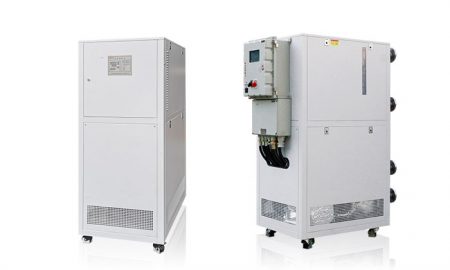Heat Circulation System
Heat circulation system is a heating system that uses thermal oil to transfer heat energy. It uses thermal oil as a heat transfer medium and transfers heat to the heating object through a heater. Thermal oil is a special liquid medium with good heat transfer performance and chemical stability. It can withstand high temperature and high pressure and is not easy to evaporate or decompose. It plays the role of heat transfer and energy storage in the heating cycle.
After the heat transfer oil in the heat circulation system is heated to a certain temperature, it is transferred to the equipment that needs to be heated through the heat exchanger and pump to heat it. During the heating process, the thermal oil flows out of the heating equipment, re-enters the heat exchanger, and is heated again, completing a heating cycle.
The heat circulation system is a heating system that uses thermal oil to transfer heat energy. Its working principle is as follows:
1. Heating source: The heating source (such as burner, electric heater, etc.) generates heat energy to heat the thermal oil.
2. Thermal transfer oil: Thermal transfer oil has good heat transfer performance and chemical stability, can withstand high temperature and high pressure, has small deformation and is not easy to leak.
3. Heat transfer medium: The heat transfer oil is transferred to the heat transfer medium (such as air, water, etc.) through the heat exchanger, causing it to be heated.
4. Return: The heat transfer medium returns to the heat exchanger, and the heat transfer oil continues to circulate and heat, completing a heating cycle.
During the entire heat transfer process, the heat transfer oil does not directly contact the heating medium, but transfers heat through the heat exchanger. This can avoid the reaction between the heat transfer oil and the heating medium, thereby ensuring the stability and safety of the system.

Features of heat circulation system:
1. High temperature stability: Thermal transfer oil can withstand high temperatures and will not degrade or deteriorate at high temperatures.
2. High heat transfer efficiency: Thermal transfer oil has high heat transfer efficiency, can quickly conduct heat energy, and does not cause phase change and expansion of materials during the heat transfer process.
3. Safe and reliable: Since the physical and chemical properties of heat transfer oil are relatively stable, corrosion and corruption will not occur during operation, thus ensuring the safety and reliability of the system.
4. Environmental protection and energy saving: The heat circulation system can save a lot of energy and fuel, reduce exhaust emissions, and has good environmental performance.
5. Low maintenance cost: The operation and maintenance cost of the heat circulation system is relatively low, because the heat transfer oil has good stability and the liquid in the system does not need to be replaced frequently, thus reducing maintenance costs.
Different from steam or direct heating, this system can better control the temperature, pressure and flow of the heating process. It has the characteristics of strong stability, easy operation, high heating efficiency, energy saving and environmental protection. It is widely used in chemical industry, building materials, food, medicine and other industries.
Correo electrónico: info@lneya.com WeChat ID: +8615251628237 WhatsApp: +86 17851209193

Termostatos de circulación
Rango de control de temperatura: +50°C a +300°C
Nota: La serie UC puede controlar la temperatura del medio de transferencia de calor. La serie UST no solo puede controlar la temperatura del medio de transferencia de calor, sino también la temperatura del material de reacción.
| Temperatura | +50°C ~ +170°C (serie UC) | +50°C ~ +300°C (serie UC) | +50°C ~ +300°C (serie UST) | ||||||
| Capacidad de calefacción | 5,5 ~ 15 kW | 3,5 ~ 130 kW | 3,5 ~ 95 kW | ||||||
| Nota: Se puede personalizar cualquier rango de temperatura de -150℃ ~ +350℃ y cualquier capacidad de refrigeración. | |||||||||
 LNEYA
LNEYA
 简体中文
简体中文


















































































